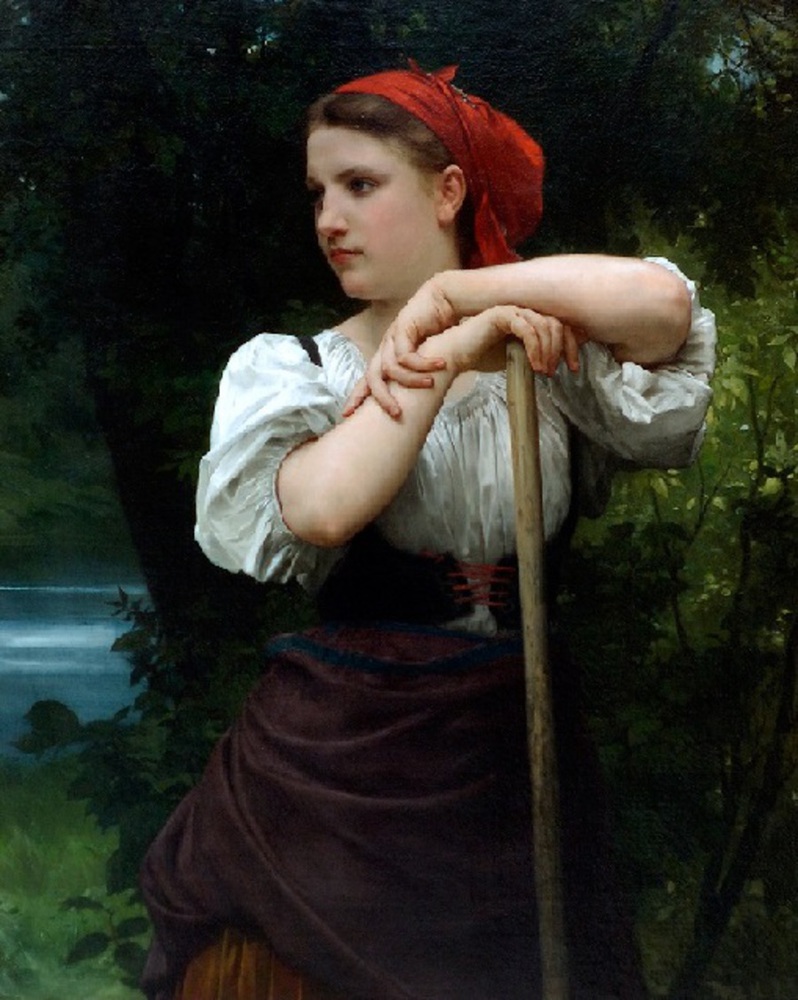These are two portraits, both of women, both facing the same direction, both with similar contemplative expressions. But that is where the similarities end. By manipulating colors, shapes, and lines in their respective pieces, Adolphe-William Bouguereau and John Graham have transformed a simple portrayal of a woman into a message about society.
Outcome
Peasant Woman - Adolphe-William Bouguereau (1869)
It is evident that there is a certain sense of beauty in Bouguereau's Peasant Woman. I have concluded that the painting conveys this beauty so subtly and accurately because of its use of light, lines, and historic connotations.
The light is clearly brightest at the woman’s shoulder and arms. Immediately, my eyes were drawn to her hands not only because they are positioned in the front and center, but also because they are illuminated by light whereas her dress and the background are relatively dark. There is also so much detail in her hands; every fold in the skin is carefully painted, while her face, for example, is smooth and not as intriguing to the eye. For that reason, I felt very interested in her hands, and after some consideration I realized that her hands are very smooth for a peasant’s. In fact, she looks very healthy and her skin seems to not have tanned from the sun.
I then became very aware of the woman’s posture. The painting skillfully uses the stick that she is resting on to accentuate the fact that the woman is standing tall and confident. She has almost a Rosie the Riveter look about her (although Rosie the Riveter did not exist at the time), and she definitely gives off a Virgin Mary vibe because of her skin complexion and the bright light and her pensive expression. Because of this, I got the impression that she was very strong, both physically and mentally.
I think Bouguereau is trying to depict the strength and beauty of lower class women. Although this woman is clearly poor, the way she is standing and the way the light hits her strikes a certain chord with the audience that makes us feel like she is full of life.
Woman in Black - John Graham (1943)
This woman, on the other hand, represents the other side of the spectrum. Graham’s Woman in Black gives the audience a sense of eeriness and mystery surrounding this woman.
At first, I thought she looked somewhat doll-like. I can attribute that feeling to the misalignment of her right eye, which looks uncomfortable and unnatural. I noticed in many abstract pieces, humans look disfigured and distorted, mostly likely because many of these abstract pieces dealt with pain and sorrow. This piece is no different, as the woman’s eye gives us the feeling that she is broken, but only subtly.
The color choices are also interesting. Many of the colors clash with each other without any blending (the black of her hair with the pink of her skin, for example). The background is also an uncomfortably bright color. In addition, there is relatively little shading on the woman’s skin, which makes her appear more two-dimensional and therefore stoic. However, the mood of the painting (eerie and mysterious) gives us the sense that something perturbs her.
I came to the conclusion that Graham is trying to critique the oppression of upper-class women. He is saying that women are suffering but they lack the strength to voice their opinions. This woman, for example, looks broken and lifeless, despite her elegant hair and expensive dress.
You can upload files of up to 20MB using this form.

